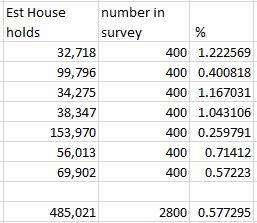the claw machine scam
Posted in Uncategorized
AstroTurf : making you seek truth from lies
A Ted talk has been forwarded to us by a member , it is extremely relevant it is only 10 minutes long and a must see
Posted in accountability, corruption, scams
Corruption in New Zealand – Open letter to the minister of Justice
Last week I made submission to the select committee on the anti corruption and money laundering bill
I note that in the bill we do not define corruption
This makes our anti-corruption initiatives extremely effective as you cannot have something which is not defined.
As such the following are NOT examples of corruption in New Zealand
1. Having a business plan to amalgamate local government duties with those of central government for private pecuniary gain then writing the bill for and advising on legislation to facilitate this
2. Making an application for law enforcement powers under that legislation pretending to be a trust when no trust exists .
3. Deceiving a minister by making false claims so as to get the law enforcement approval
4. Getting law enforcement powers for a fictional body by pretending that it is a legal person when it is not.
5. Operating that Fictional law enforcement body from council premises using the staff vehicle and infrastructure for private pecuniary gain
6. Setting up a pretend trust in 2006 to pretend to be applicant and issuing court action to cover up
7. Deceiving the court through lawyers and denying the defendant a hearing or the right of defence of truth and honest opinion so as to re write history using a court judgement obtained through deceit
Through the journey I have found that we effectively try to Kill off Whistle-blowers , through stress financial hardship and making their life hell on every front as such a simple question of “ why does that law enforcement authority not exist as a legal person ?” has cost me my family , my marriage, nearly 10 years of my life well over $400,000 hard cash and goodness only knows how much in lost earnings.
I took on a lawyer who has since been found by the courts to have been “ incompetent “ he is now suing me because I complained of double billing. I made a complaint about a billing issue 4 years ago , it is still not resolved and instead the lawyer has taken me to court in a series of actions seeking to bankrupt me when he has overcharged me some $28,000.- message- don’t complain about your lawyers double billing – he will sue you and make your life hell .
I am a licenced Private investigator and former long serving police officer , I know a thing or two about fraud and corruption and I know that it is impossible to report fraud and corruption in New Zealand because it damages our clean green image.
I have found the greatest issue to be that lawyers are not held accountable to the rule of law, and crooked lawyers have a licence to use our legislation in the most convoluted manner to cover up fraud and corruption . The law society has conflicting roles of member society and lawyers authority , nothing is going to change until those conflicting roles are separated .
The so called public watchdogs, are under resourced and under staffed by competent personnel and we function be throwing up walls for people to bang their heads up against until they either drop dead or go away.
My matter is well researched, I have a ton of documents, from the government’s own files , No government authority has ever looked at them , they all claim it has been through court and it is therefore settled.
This proves that using the court to conceal fraud and corruption in new Zealand works and makes this even more serious.
I have even gone to the extent of filing a petition for a commission against corruption only to find that Mike Sabin, who was on the wrong side of the law himself , threw it out because my evidence disclosed fraud.
It appears that peoples reputations are paramount, that is their reputations not mine – My crime is to have exposed corruption and I have paid a very high price .
I request that you use my scenario as an investigation into corruption in New Zealand , it proves that it exists at every level and that we would sooner shoot the messenger than deal with the real issue.
Are you the minister who will turn corruption in NZ around ? I hope so for all our sakes
Regards
Grace Haden
Posted in accountability, corruption
Was Mike Sabin’s disposal of the petition for a commission against corruption lawful ?
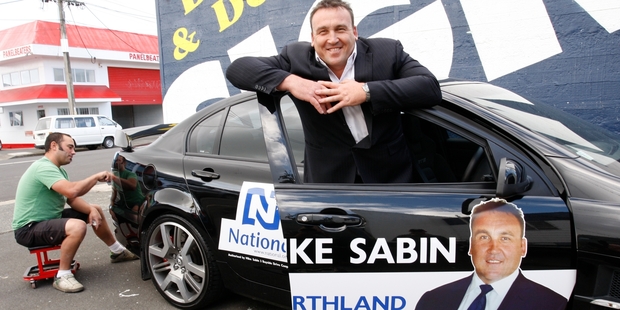 From: Grace Haden
From: Grace Haden
Sent: Tuesday, 3 February 2015 2:20 p.m.
To: ‘select.committees@parliament.govt.nz’
Cc: ‘jonathan.young@parliament.govt.nz’; ‘lindsay.tisch@parliament.govt.nz’; ‘ian.mckelvie@parliament.govt.nz’; ‘phil.goff@parliament.govt.nz’; ‘Kelvin.Davis@parliament.govt.nz’; ‘david.clendon@parliament.govt.nz’; ‘Mahesh.bindra@parliament.govt.nz’; ‘KanwaljitSingh.Bakshi@parliament.govt.nz’; ‘Andrew Little’
Subject: Petition for a commission against corruption
Good afternoon
Last year Andrew Little presented my petition for a commission against corruption
I am a former police officer and now a private Investigator who has found herself at the fore front of corruption In New Zealand because I believed the spin that NZ was corruption free.
I thought it was the proper thing to do, to draw attention to the fact that a man had written legislation for his own business plan, advised on it at select committee level and then using a false name applied for the coercive law enforcement powers which he had helped create.
The powers were under the animal welfare act and he claimed that he made an application on behalf of a trust called the Animal welfare Institute of New Zealand(AWINZ ) . The trust was fictional, the minister was misled and no one checked that the Animal welfare institute of New Zealand existed.
In 2006 a lady working at the Waitakere city council dog control unit asked me if I could find out who or what AWINZ was. The council vehicles and the buildings had been rebranded to have the appearance of belonging to AWINZ, the council officers were required to Volunteer their council paid time to AWINZ and prioritize animal welfare over dog control . The prosecutions were performed by the council dog control manager who was one and the same as the person who had written the bill which ultimately became foundation for the law. This was a classic case of public office for private pecuniary gain – which is deemed to be corruption by international standards.
Through my journey with corruption many people have come to me and have told me of the brick walls which they , like me have encountered. The police say they had no time , the SFO say not serious or complex, the ombudsmen took 2 ½ years to get a document then went quite ,the office of the auditor general total ignored it .. IT HAS NEVER BEEN INDEPENDENTLY INVESTIGATED except by the society for promotion of community standards , who confirmed what I had alleged.
In having my petition rejected, I have struck yet another brick wall and again things are done with an appearance of legitimacy but without any real legal foundation and ability.
Mike Sabin rejected the evidence of my petition on the basis of standing order 236 b . this quite clearly states that the evidence is considered to be an irrelevant or unjustified allegation can be expunged. It does not state that all of the evidence can be thrown out and indeed there are various issues raised in my evidence not just that of AWINZ .
236 Irrelevant or unjustified allegations
When a witness gives evidence that contains an allegation that may seriously damage the reputation of a person and the select committee is not satisfied that that evidence is relevant to its proceedings or is satisfied that the evidence creates a risk of harm to that person, which risk exceeds the benefit of the evidence, the committee will give consideration—
(a) to returning any written evidence and requesting that it be resubmitted without the offending material:
(b) to expunging that evidence from any transcript of evidence:
(c) to seeking an order of the House preventing the disclosure of that evidence.
It concerns me that Mike SABIN was so actively involved in the removal of this petition and in light of the events of the last week it is entirely possible that a conflict of interest existed.
Mr SABIN does not state that the allegations are irrelevant or unjustified , and 236 b clearly states “to expunge that evidence from any transcript of evidence “ this does not give open licence to dispose of all of the evidence.
Additionally my evidence does not make it clear that the matter has been” thoroughly investigated” my evidence is that it has never been investigated by the proper authorities .
As a former Police officer Mr Sabin is well versed at writing complaints off but this is a matter before parliament , it needs to be dealt with according to the rules and I do not see that 236(b) can have all the evidence expunged.
Additionally standing Orders have ways of dealing with evidence which could have impact on persons reputation . I have deliberately not named any one however the evidence in support which were obtained from government and council files show who the players are in the game. The Animal welfare institute of New Zealand does not have legal existence hence does not have any legal rights and therefore cannot have a reputation .
It is precisely the use of such fictional personas which makes fraud prevalent in new Zealand , this practice is being condoned and this is exactly why we need a commission against corruption . It is a huge elephant which is being ignored.
I request that the committee review the manner in which this petition has been disposed of and ensure that it was done lawfully if they up hold the decision. I am happy to resubmit eh evidence with names removed if that assists .
Additionally under the OIA I request the names of those who sat on the committee with Mr SABIN and voted on dumping the petition and writing the letter attached above and the minutes pertaining to this .
I will be publishing this letter on www.transparency.net.nz as the public have a right to know .
Regards
Grace Haden
Phone (09) 520 1815
mobile 027 286 8239
visit us at www.transparency.net.nz
Posted in accountability, corruption, identity, identity concealment
Proposed Air Quality Bylaw- Information received from Auckland Council
 Last year Auckland council announced a Proposed Air Quality Bylaw, this drew an editorial from the Herald and concerns from us and others as to where the facts and figures came from. Bernard Orsman also did a article entitled “City plan spells end for old flames” and “Plan to ban open fireplaces affects thousands of homes”
Last year Auckland council announced a Proposed Air Quality Bylaw, this drew an editorial from the Herald and concerns from us and others as to where the facts and figures came from. Bernard Orsman also did a article entitled “City plan spells end for old flames” and “Plan to ban open fireplaces affects thousands of homes”
the committee is due to meet in February on their web site the council provides the governing body report and an article about managing Auckland’s air quality .
the questions we asked were
1) All research which has been conducted into this matter – showing location and time frames over which this has been monitored.
Their response :The Herald article mentions the number of households that would be affected by any proposed ban of older wood burners and open fires.The information on total number of households using wood for home heating was taken from the 2013 census. The proportion of wood burners using old wood burners (pre 2005) and open fires was then calculated using information from the 2012 Auckland Council Heating Survey (attached).1. 2012 Auckland Council Home heating survey result
Our response :in the report the word assume features 14 times and “estimate” 64 times , they conducted the survey based on responses and not actual emission readings . the data was obtained from
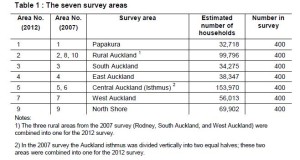 In terms of % this is what they surveyed
In terms of % this is what they surveyed
this is the area they surveyed 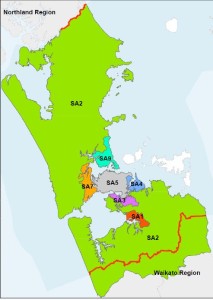
Now just by applying logic you will find more people in the rural areas using open fires than in the central city .
In total just over half a percent was surveyed of which 50% lived outside the isthmus area.
The isthmus area has the greatest population and has greater pollution from other sources eg. vehicles
It is of note that there appear to be actual measurements and pollution readings.
2) Evidence that the domestic fire places are to blame for deaths in Auckland as implied by Councillor Darby.
Their response :The Herald article also mentioned the number of people affected in Auckland by discharges of fine particulate (or PM10) from domestic home heating information. The number of people affected by PM10 from domestic home heating was taken from the evidence of the health effects of indoor fires as well as all other sources of PM10 emissions can be found in the following the independent report: “Updated Health and Air Pollution in New Zealand Study 2012 ” this report will also answer questions 6 and 7.
HAPINZ_Update_Vol_1_Summary_Report
Our response : The word assume appears 31 times in this document and Estimate 141 times.
“The authors estimated that air pollution from all sources in New Zealand was responsible for approximately 1,400 premature deaths per year, of which 1,100 premature deaths were attributed to anthropogenic (human-caused) sources” this statement could easily cover deaths from smoking .There appears to be no evidence that wood fires are responsible for or contribute to these deaths 2.1 discusses these issues along with “sources such as burning coal, oil, wood, petrol and diesel in domestic fires, motor vehicles and industrial processes”
HAPINZ_Update_Vol_2_Technical_Report
Our response : The word assume appears 34 times in this document and Estimate 132 times It appears that this report relates to NZ generally and not to the specific issues of wood burning in Auckland . Health figures are also not available for Auckland. Christchurch and Auckland have vastly different demographics and the issues and problems there cannot be applied to Auckland.
3) Research which shows that fireplaces since 2005 emit less particles than those prior to 2005, please supply details of makes and models.
Their response :The New Zealand Government introduced the National Environmental Standards for Air Quality (AQNES) in 2004. The regulation set national standards for air quality and introduced the new design standard for wood burners; they had to meet new emission and efficiency standards from 2005 (discharge less than 1.5gm/kg of particle for each kilogram of wood burnt and have a thermal efficiency of not less than 65 per cent). The AQNES required all models of wood burners sold to be tested to ensure they meet these standards, a list of wood burners that meeting the standards is kept on the Ministry for the Environment (MfE) website. (see attached National Environmental Standards for Air Quality)
Prior to the AQNES there was no national standards for the emission levels or thermal efficiency, however some testing has been carried out on older wood burners. (see attached Real Life Emissions Testing of Pre 1994 Woodburners in New Zealand)
Our response : So why the 2005 cut off when quite clearly some pre 2005 wood burners are complaint why not place a specification on types. 11 years passed between 1994 and 2005 and those who installed their wood burners in the early 2000’s may well have compliant burners.
4) Comparisons of fine particle pollution in Auckland to other cities, at what height does it occur, how long does it linger or disperse, is our isthmus location an attribute which makes air linger?
Their response :The council does not keep records of air quality monitoring undertaken in other areas of New Zealand. However a summary of all ambient air quality monitoring undertaken in New Zealand can be found on the Ministry for the Environment website.
Whilst other cities in New Zealand such as Christchurch and Rotorua have more incidences of air pollution caused by fine particulates (PM10) the Resource Management (National Environmental Standards for Air Quality) Regulations 2004 requires all regional councils to meet the limits on the number of exceedances of the PM10 standard as specified in the regulations. Areas such as Christchurch and Rotorua have a higher level of historical exceedances of the PM10 standard and have more time than Auckland to meet the requirements of the regulations.
The monitoring undertaken in Auckland is done using fixed monitoring sites that sample the air close to the ground; they measures the air that people are exposed to and breathe. Exceedances of the PM10 standards in Auckland and other areas occurs during periods of cold and calm weather during winter when the pollution from domestic fires collects under temperature inversions caused by the conditions.
Being particulate matter the time it takes for PM10 to settle out will depend on climatic conditions such as wind speed and direction. On very still evenings it is likely that PM10 will remain near the fires that produce the particulate. Exceedances of the PM10 standard in the last 5 years have been found at monitoring stations in Takapuna, Pakuranga and Khyber Pass.
9. Exceedences to Date Auckland Council 2005-2012.
Our response : the spread sheet actually mentions how long and why these limits were exceeded at the time – House fires etc, the exceedence is minimal considering the circumstances.
5) Consideration to existing usage rights, traditional .. going back to the year dot.
Their response :There are no existing use right for any fire if it causes a health nuisance because of large levels of particulate emissions. The AQNES allows councils to make bylaws that are more stringent than the regulations.
Our response : But why make by laws when they are not requires and will not have any impact on the problem you are trying to solve or a problem which does not exist.
6) The dangers of open fire/ firebox pollution as opposed to industrial, vehicle pollution and cigarette smoking.
Their response :The Updated Health and Air Pollution in New Zealand Study (HAPINZ) (attached) looked at health effects and included a number of New Zealand and overseas studies on health effect from fine particulate. There are a number of studies that have looked at health effects from wood smoke compared to other combustion particles i.e. vehicles, cigarettes smoke etc.
(Air pollution combustion emissions: Characterization of causative agents and mechanisms associated with cancer, reproductive, and cardiovascular effects, Woodsmoke Health Effects: A Review, first published in Inhalation Toxicology 2007)
Our response : But how does this relate to Auckland????
7) Who conducted the research, how was it verified, which standards were applied.
Their response :The HAPINZ report was undertaken on behalf of the Health Research Council of New Zealand, Ministry of Transport, Ministry for the Environment, NZ Transport Agency and was based on Epidemiology studies similar to that used to determine the effects of cigarette smoke. If you have any question about this study please contact the authors of the HAPINZ report.
The following reports have been used as to support the proposed Air Quality Bylaw. These are also attached to this response for your reference.
• 2012 Home Heating Survey Results (TR 2013/011), April 2013as above
• Census output – wood use in Auckland 2001 to 2013 
• Statement of Proposal – Introduction to the Air Quality Bylaw 3. StatementofProposal introduction of the air qua
It would appear from this docuemtn that the cause of our pollution is not from domestic fires, but we guess its easier target the rate payers and residents that the industrial sector.
• Updated Health and Air Pollution in New Zealand Study – March 2012, volumes 1 and 2.as discussed above
• National Environmental Standards for Air Quality (Update June 2011)4. National Environmental Standards for Air Qualit
this is the statute . there is no evidence that we do not comply with statute . ther is a design standard referd to in the statute at (23) , the statute states that these wood burners should not be installed after 1 September 2005 it does not say they need to be removed.
• Domestic Fire Emissions 2012: Options for Meeting the National Environmental Standard for PM10. (TR 2013/022)5. domesticfireemissions2012optionsformeetingnatio
this document states “Domestic fires are a major source of particulate in the Auckland region, contributing to 41 per cent of total annual PM10 emissions and 43 per cent of PM2.5 emissions in 2011 (Auckland Council, 2012a). Levels are even higher during winter, with domestic fires accounting for 70 per cent of daily PM10 and PM2.5 emissions on a typical winter’s day. The annual social cost of health effects associated with domestic fire pollution is estimated at $411 million for the Auckland region ($NZ as at June 2010, Kuschel et al., 2012).” What we are looking for is the evidence upon which that statement is made.
• Air Quality Domestic Options – Cost Benefit Analysis 2012 (TR 2013/0X29)6. airqualitydomesticoptionscostbenefitanalysis201 the word assumption appears 24 times in this 44 page document and Estimate 27 time. there is no REAL data. There is no analysis of what is in the air specific to Auckland
• Real Life Emissions Testing of Pre 1994 Woodburners in New Zealand this is pre 1994 there is no evidence that wood burners 1994-2005 are non compliant .
• Clean Healthy Air for All New Zealanders: The National Air Quality Compliance Strategy to Meet the PM10 Standard, MfE, 1 August 2011.Download PDF (945 KB) Ministerial document setting he limits for air pollution, we have so far not seen any evidence that Auckland exceeds these limits
• Exceedances to data: Auckland Council 2005 – 2012 as discussed above the excrescences are due to exception circumstances
• Woodsmoke Health Effects: A Review, first published in Inhalation Toxicology 2007 10. Wood Smoke Health Effects A review first publi this is a document wEstimate 28 times there si no REAL data hich speaks of the dangers of air pollution , we do not dispute that, we want to see factual evidence that there is air polution n Auckland caused by wood burners.
• Air pollution combustion emissions: Characterization of causative agents and mechanisms associated with cancer, reproductive, and cardiovascular effects 11. Air pollution combustion emissions (health).pd this is a document which speaks of the dangers of air pollution , we do not dispute that, we want to see factual evidence that there is air polution n Auckland caused by wood burners.
• ARC – estimation of Domestic Fire Emissions in 2006.12. ARC Estimation_of domestic_woodburner_emission note the word estimate appears in this 59 page document 138 times. it even appears an additional time in the title . The word assume or derivatives there of appears 105 times – Our question How factual is a document based on estimates and assumptions ?
ARC_SA_Presentation_GNS_9_May_2008 If this report was an account it would be thrown out due to its data being over 7 years old , the cover photo loos suspiciously like morning fog as opposed to pollution.
Posted in accountability, Super city
Its time to sort out the confusion with regards to law firms.
 The law society have a statutory duty to deal with two groups of persons – lawyers and incorporated law firms .
The law society have a statutory duty to deal with two groups of persons – lawyers and incorporated law firms .
The first one is seemingly straight forward a lawyer gets a practicing certificate and is for that year a lawyer and is placed on the law societies register .
The law society also provides a page called “Find a Lawyer or Organisation” and by entering a name onto that search field and selecting “organisation” names come up.
Basic logic would have you think that the “organisations’ would be incorporated law firms but that is not so. The reality is that the organisation search is grossly deceptive, to such an extent that even the staff administering the register cannot tell you if these ” organisations “are incorporated law firms or not.
An incorporated law firm is defined as
incorporated law firm means, subject to sections 15 and 16, a company that—(a) provides to the public services that are, in relation to a lawyer, regulated services; and(b) has as its directors no persons other than lawyers who are actively involved in the provision by the body corporate of regulated services; and(c) has as its shareholders, in respect of shares that confer voting rights, no persons other than—(i) lawyers of the kind described in paragraph (b); or(ii) persons who are administrators of the estates of persons who, at the time of their death, were lawyers of the kind described in paragraph (b); and(d) has as its shareholders, in respect of shares that do not confer voting rights, no persons other than—(i) lawyers of the kind described in paragraph (b) (any 1 or more or each of whom may, but none of whom is required to, hold those shares as a trustee of a qualifying trust); or(ii) persons who are relatives of lawyers of the kind described in paragraph (b); or(iii) persons who are administrators of the estates of persons who, at the time of their death, were shareholders of the kind described in subparagraph (i) or subparagraph (ii)
the act then goes on to relies on section 21 Provision of legal services for the protection of legal services and states
(1) A person commits an offence who, not being a lawyer or an incorporated law firm,—(a) provides legal services in New Zealand; and(b) describes himself, herself, or itself as—(i) a lawyer; or(ii) a law practitioner; or(iii) a legal practitioner; or(iv) a barrister; or(v) a solicitor; or(vi) a barrister and solicitor; or(vii) an attorney-at-law; or(viii) counsel.
So does this mean that a firm which is not a law firm does not commit an offence if it provides legal services and
- cannot be identified as a person
- does not call itself lawyer, barrister etc as above.
section 22 Misleading descriptions
It is clear that this section is there for non lawyers who hold themselves out to be lawyers but what if a lawyer is holding a fictional company out to be a law firm. – section 23 does not give much support, it appears to exonerate actions as long as there is a lawyer involved somewhere in the process.
But Lawyers have rules too , they are enforced more or less through the law society . However the law society is frequently conflicted in their roles of membership organisation and a disciplinary body.
It is after all lawyers controlling their own and this too of deception has been part of a lawyers artillery for centuries so why should they give away a tool of deception ? It suits lawyers and the law society to be vague about law firms as this way they preserve their fidelity fund as no one can bring a claim against a fictional law firm.
The rules of conduct are found here You may be wondering why we have brought this issue up .. well it is for very good reason it is one of those twisty nasty tings which makes lawyers always right and you always wrong.. In our opinion it is Identity deception/fraud.
Our director engages a lawyer .. she met him in what she believed to be the offices of his law firm Equity law Barristers Limited , he sends away a staff member to complete the contract and a contract emerges in the name of Equity law Chambers .
The law practice is referred to as Equity law regularly in correspondence and the current web page at the time shows the People involved with what is referred to as Equity law.
Equity Law barristers Limited started its life as Equity law 2007 limited. there are no other companies on the companies register which bear the name “equity law ” and the company now known as Equity law barristers is shown as having been co directed by the the lawyers wife and she also held 50% shareholding of the company up until 16 November 2011 this means that by the legal definition of Incorporated law firm equity law barristers was not and could not have been an incorporated law firm at the time when it agreed , under a trading name to provide me with legal services.
The agreement was that Barristers from within the chambers supervised by the head of chambers, were to do the work . However the staff who worked on my matter were generally new graduates who had neither been admitted to the bar and therefore did not have a practicing certificate ( you will also find that the law society claims privacy when you ask who had a practicing certificate when )
Inquiries with the law society have complicated matters further , they tell me that Equity law barristers limited was an ” an incorporated barristers practice ” from November 2008 they will not go so far as to say if it was incorporated law firm and they will not say on what basis it is an incorporated law firm. – vagueness is protecting their fidelity fund.
On the other hand the court is very strict on identities a company is a separate legal identity from a person but here were have a situation where a company is using a trading name and the director has now claimed the trading name as his own. The law society in their wisdom made a decision naming the director of Equity law barristers limited and told him to reduce his invoices and refund our director. However he refused we now have a gigantic mess where by the incorporated barristers firm may not have been an incorporated law firm and could not have provided andy legal services, but because there was a lawyer hanging about in the side office it is not an offence.
Another point of interest with this law firm is that the shareholder and other director the Lawyers common law wife appears to have had her signature forged. But that wont matter either they will have some explanation for that like a sprained wrist .
It appears that the law applies strictly to us and loosely to lawyers .. that has to change.
This brings about massive identity issues and made us focus on the organizations which the law society lists.
Many of the ” law firms ” are just trading names, unidentified trading names
some of the limited liability companies listed do not qualify as Incorporated law firms because of the share holding issue.
Solicitors trust accounts which do have lawyers as directors and share holders are not incorporated law firms but would qualify on face value as such .
This whole area is a massive deception
Stewart & Associates Equity Law still appears on the ” organisation list” it is neither a company nor is it a firm as it only has one employee a lawyer who is not capable due to her lack of seniority to practice on her own account.
Also look at Brookfields and Brookfields – Wellington branch , who is it a trading name for ? it could be any of these or none.
It is time that the law society tidied up their ” find a lawyer data base. we the public should be able to go to the database and identify the law firms and the lawyers practicing in their own name.
Posted in accountability, Equity law, identity, identity concealment
The curious case of Equity Law and Equity Trust International
 There is a very big anomaly in New Zealand with regards to law firms , they are not readily identifiable and even the law society has trouble telling you what is a law firm and what is not a law firm.
There is a very big anomaly in New Zealand with regards to law firms , they are not readily identifiable and even the law society has trouble telling you what is a law firm and what is not a law firm.
Lets look at some entries on their register at a listing for Stewart and associates Equity law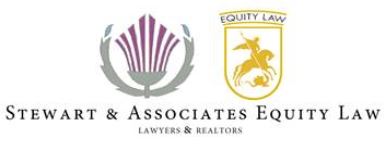
You wont find it on the companies register and even the registration on the solicitors roll is deceptive as the address is in Auckland and the phone number is in Alexandra.
Also you have to wonder how an organization can operate from a Po Box. .. bit cramped we would have thought .
Try to physically locate it and you will never find it as the ” organisation ” doe not exist and it is indeed a fictional law firm .
This fictional law firm, fictional entity is however the instructing solicitors in court action agaisnt us . The law firm only has one lawyer a young lady named Julia Leenoh. Julia is not her real name and neither is Leenoh apparently as she does not appear to have obtained her degree in that name and appears to be Joo Yeon Lee
Now this fictional law firm came about apparently through the ” merger” with Equity law .
Now the objective of this blog post is to identify who or what Equity law is .. I warn you you are going to get dizzy .
It is of note that when the proceedings were commenced against us the fourth plaintiff was identified as Equity Chambers we then received a memorandum to say
“This document notifies you that the fourth Plaintiff was incorrectly named as Equity Law Chambers. It should instead be amended to Equity Law Barristers Limited, as incorporated company, having its registered offices at Level 4, Khyber Pass Road, Grafton, Auckland. ”
We had rather foolishly thought that equity law was equity law barristers as all the signage in the building indicate  equity law as being inthe building and when our director had close relationships with the law firm it appeared to be a law firm .
equity law as being inthe building and when our director had close relationships with the law firm it appeared to be a law firm .
let us look at the history of Equity law .. assuming that it is the company Equity law barristers Limited
the company was formed 19 Dec 2006 as Equity law 2007 Limited
Captures from the way back machine show the very first we presence that they captured on 17 August 2007
the web site was registered 20:19 27/3/2007 to equity law Limited we note that there is no such company as Equity law limited but even the registrar of domain names agrees that this must be the company which owns the web site becasue the other associated companies did not exist at that time
Equity trust International Limited was incorporated 26 may 2008
Equity trust International tax agents Limited was incorporated 15 November 2011
Going back to Equity Law 2007 Limited we note that it had two directors
These two persons are also involved in the legal action against us .
Action was originally taken agaisnt a member and when the plaintiffs agreed it was an error they eventually submitted proper documentation which shows the other plaintiffs signatures.
this is the signature of the second Plaintiff 
 now look at the initial filing documents of the company for this same person and the signature is some what different the
now look at the initial filing documents of the company for this same person and the signature is some what different the  full document is on this link it is the fourth document from the bottom this and the share holder link is this the actual signature for the share holder is this
full document is on this link it is the fourth document from the bottom this and the share holder link is this the actual signature for the share holder is this
Our research shows that the actual signature is the very first one
to us it appears that a law firm has been set up using fraudulent signatures. But could it even have been a law firm ? seems like no one can tell us. Now The director of the firm claims that Equity law is a trading name he used. so the plot thickens. perhaps we will never know.
The dubious signatures are a bit ironic as a member of the chambers was Frank Deliu who defended Lu Zhang “
Lu Zhang, 28, is accused of 75 offences of making false statements in company registration forms after she declared her office address was her residence in 75 companies she registered.
She was charged after a plane loads of weapons, including rockets and grenades, from North Korea bound for Iran was seized in Bangkok last year.
another new item is also worthy of reading this is an extract
“Former fast-food worker Lu Zhang, 28, was the sole director of Queen St registered SP Trading Ltd, a company that hired a plane discovered at Bangkok airport last December flying 25 tonnes of arms from North Korea to an unknown destination, believed to be Iran.
Zhang pleaded guilty yesterday to 74 charges of giving false residential information to the Companies Office, which registered multiple companies with her as a director. She could have faced up to five years in jail and/or a fine of $200,000, but was convicted and discharged.
Her lawyer, Frank Deliu, revealed that the Chinese ambassador in Wellington, Xu Jianguo, had written to Zhang’s immigration consultant, former immigration minister Tuariki Delamere, who had briefed him on what was happening. Mr Xu’s letter was included in affidavits.“ see article
it is interesting to note that Tuariki Delamare operates a floor below that of Equity law see this
The entire building appears to be abuzz with inter connected activity just recently the bank Breder Suasso was found operating on the second floor with a fake reception see the news item here
The fourth Floor of 44 Khyber pass used to be just the law firm and the travel agent next door but now we have a raft of activity there including forex traders and Equity trust International which sets up new Zealand companies for foreigners .
The instructing solicitor in the action against us is Greg Stewart , although he works in Alexandra he is the director of this company and also supervised Julia Leenoh from his desk in Otago .
we have now got a most confusing situation where by the court papers filed Greg Stewart claims that Equity law barristers limited was not the law firm called equity law in one lot of proceedings and claims that it was in another lot of proceedings.
the Statement of Claim and the Bundle for defence part 1 and Bundle for defence part 2 AND Bundle for defence part 3 and the defamation defence COMBINED are at the links
they have been served on the lawyer who is appearing on the matter and who has been signing the submissions but refuses to file a representation . this is Michael Locke we believe he is the one and the same who appears on the insolvency web site having been recently released from bankruptcy 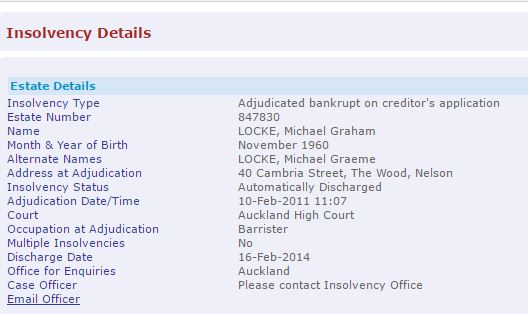 .
.
The plaintiffs have been attempting to silence us because the truth is inconvenient
our revelations that the former lawyer did not have a proper law firm, and the fact that the associated trust firm passes itself off as a ;w firm is of concern. as are the mention of 10 million dollar bank accounts, solicitor escrow accounts and the offer of passports from the Dominican republic, St Kitts and Nevis as second passports to open up the world for would be investors.
Interesting holiday reading of what he world so called second least corrupt country facilitates.
We stand by our research the truth is the truth .
Transparency International New Zealand will you unmask the corrupt ?
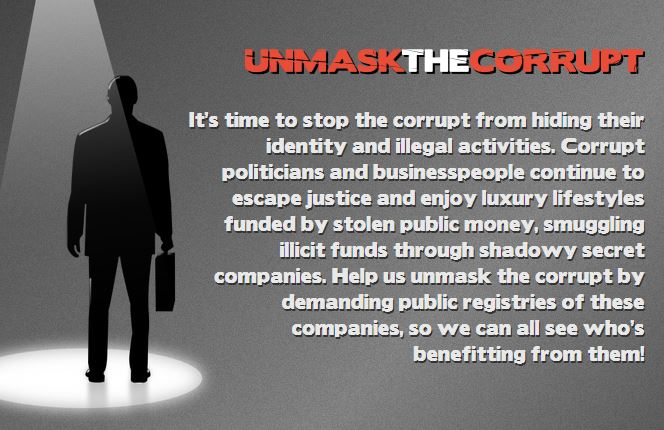 Transparency International are running an excellent campaign called Unmask the corrupt .Ironically this is what we have been doing and have been sued for , that is because we have been doing it on our own.
Transparency International are running an excellent campaign called Unmask the corrupt .Ironically this is what we have been doing and have been sued for , that is because we have been doing it on our own.
There is a vast difference between Transparency International and their NZ branch , The New Zealand branch dedicates it web site to showing how well we are doing at being ” corruption Free” while the rest of the world actually fights corruption.
We often point out that if you ignore cancer you will succumb to it , the same is true of corruption.
We have New Zealand companies involved in international trade, not all of it legitimately see this news item.
Naked Capitalism a web site operated overseas by a number of top class journalists and connected to the international consortium of investigative journalists have published a number of articles with regards to the activity of Money laundering in New Zealand see this post entitled “New Zealand, Fresh From Its Service to Mexican Drug Lords, Helps Out the Russian Mafia” and a more recent onesNew Zealand’s GT Group in Romania, Moldova and the UK,
While New Zealand’s Company Law Reform Stalls, GT Group Helps a Thieving Ukrainian Despot
New Zealand: Pseudo-Financial Companies, and GT Group, Both Still Going Strong.
What is significant is that the Government thinks that they have closed down the GT group but many of the companies once administered by a new zealand company .Just one such example is GT GLORIA TRADING
This company overseas companies and has a disproportionate Russian representation .
Even many of the people involved are what we call name shifters and so are the companies themselves , this is so that you never really know who you are dealing with .
Alex Bushe of equity law also appears to be one and the same as Alexander BUSHUEV, who is the director of a number of Equities companies SEDLEX LIMITED (5058320) – Director & Shareholder GLOBAL WEALTH GROUP LIMITED (5433544) – Director & Shareholder FIDELIS INTERNATIONAL TRADING LIMITED (5318101) – Director & Shareholder BLACKLIST DEBT RECOVERY LIMITED (4361899) – Director & Shareholder STEIGEN MAKLER LIMITED (5170404) – Director & Shareholder DRAGON GROUP LIMITED (5433581) – Director & Shareholder
another such person is Gregory Shelton who also appears to be the one and the same as Grigori CHELOUDIAKOV who took over the shareholdings of several companies including IMEXO PRANA and CRESTPOINT TRADE
Both of these companies had former director latvian Inta bilder and are associate to the companies involved in this news item NZ shell company linked to alleged $150m fraud AND SEE the latvian proxys
So needless to say we whole heatedly support the initiative of Transparency International in the UNMASK THE CORRUPT CAMPAIGN .
Submissions to Auckland Council
 Delegation, calculation of penalties and applying penalties to Rates A dogs Breakfast
Delegation, calculation of penalties and applying penalties to Rates A dogs Breakfast
By Grace Haden
I ask for these notes and the attachments to be appended to the minutes.
I have been assisting Penny Bright in making sense of her rates demand, this has given me cause to look at the processes involved and the manner in which the penalty regime has been approached. In doing so I have noted a number of issues which require resolution.
Delegation
Serious issues arise with the delegation of the powers under the Rating act
The annual plan in 2013 & 14 both state
Delegation of decision-making
Decisions relating to applying the rates under the rates related policies will be made by council officers.
The legislation Local Government (Rating) Act 2002 however states
132 Delegation
(1) A local authority may delegate the exercise of functions, powers, or duties conferred by this Act on the local authority to—
(a) its chief executive officer; or
(b) any other specified officer of the local authority.
(2) A local authority must not delegate—
(a) the power to delegate; or
(b) a function, power, or duty conferred by subpart 2 of Part 1 or subpart 1 of Part 5.
The question therefore is who ultimately has the delegated powers and who can lawfully make decisions with regards to the rates and consequently the penalty regime.
It is important to resolve the matter of delegation before we consider whether or not rating polices are legal
Applying penalties to Rates
The sequence of events is also crucial
1. The person who holds the delegated powers or powers has to be identified.
a. I have been unsuccessful in getting this information Mr Town responded this morning Rates and their setting is not delegated but is adopted by the Governing Body as required by law. Therefore no staff member has this delegation. However, delegations for different parts of the implementation of the rating system rest with different staff members depending on what is required.
b. It appears to me that what we have in the annual report and what is required by law is not expressed clearly also the act makes it clear that responsibilities can be delegated to A specified officer not “different staff members depending on what is required”
2. A resolution must be made to authorise penalties to be added to rates no later than the date when the local authority sets the rates for the financial year, It follows logically that this resolution must be available to be produced and one would think in this day an age available for public inspection on the internet. And
a. It has to stipulate how the penalty is calculated
b. the date that the penalty is to be added to the amount of the unpaid rates
c. and must not exceed 10% of the unpaid rates.
3. Section 58 sets out the various types of penalties which the council can impose and it would follow that these are the only penalties which can be imposed .
4. This penalty regime MUST be conveyed in the assessment notice. see assessment notice
There is much confusion as to who really holds the responsibilities as to setting the penalty regime and there is also confusion as to the regime itself.
The annual plans all state: The council must use the special consultative procedure set out in the Local Government Act 2002 to adopt and amend the rates related policies.
The act on the other hand is specific in that it states that the policy must be set “By resolution no later than the date when the local authority sets the rates for the financial year “
This implies that this policy must be set or adopted by resolution annually
In the annual plan 2013-2014 states
The council will apply a penalty of 10 per cent of the amount of rates assessed under each instalment in the 2013/2014 financial year that are unpaid after the due date of each instalment. Any penalty will be applied to unpaid rates on the day following the due date of the instalment.
and 2014-2015
The council will apply a penalty of 10 per cent of the amount of rates assessed under each instalment in the 2014/2015 financial year that are unpaid after the due date of each instalment. Any penalty will be applied to unpaid rates on the day following the due date of the instalment.
A further 10 per cent penalty calculated on former years’ rate arrears will be added on the first business day of the new financial year (or five days after the rates resolution is adopted, whichever is the later) and then again six months later.
The words applied to do not necessarily mean that the penalty will become part of the rates and incorporated into the rates. The wording is not specific as to how the rates and penalties are calculated.
Further :The act requires the invoices to show the amount of the penalty on any unpaid rates for the rating unit and the amount of any unpaid rates owing from a previous financial year for the rating unit. The connotation is therefore that the rates and the penalties are two separate amounts and not one.
This brings about the question of whether or not penalties can be applied to penalties, if there is no resolution that penalties are added to the previous year’s rates then the next lot of penalties applied can only be applied to rates and not rates plus penalties.
The next issue which arises is the rates due for the financial year.
The invoices tates Total rates payable for 2014-2015.
Unless the resolutions to set dates for instalments can be shown to have been made legally and with the proper consultation they cannot be enforced.
The invoice shows the sum due for the year but nowhere on the invoice is there a date by which that sum is due .
There an ability to pay a reduced sum in one payment and getting a hefty 1.1% discount if the payment is made by the first instalment date, the other options available are to be penalised or to pay instalments.
Every one paying their rates on time effectively pays a full month prior to the end of the financial year. Nowhere does it state that the full rates are due by that date.
Penalties are not equal
People living in higher priced areas pay higher penalties as can be seen by the two different invoices I have produced. The penalty for late payment in Epsom is $112.70 per quarter and In Kingsland $58.10 per quarter. This is significant and a flat penalty fee should be considered due to the ever increasing property prices.
calculation of penalties
Unlawful penalties
The act allows penalties of up to 10% of the rates to be added, it does not say per annum and this allows the council to continually add 10% the rates at 6 monthly intervals if an amount is a year old. This is in excess 20% and makes loan sharks look good.
While 10 % is legal the e reality is that a penalty in excess of 10% is added.
10 % is being added to the GST inclusive price, this price is already 15% more than the set rate.
While council through legally set penalty regimes can charge up to 10% penalty on rates they have no legal ability to charge 10% penalty on GST.
This also raises the question of the GST which the council then declares to IRD as having been received but that is a matter for you.
Taking Penny’s rate bill for example the rates instalment is $581 of which $75.78 is GST by charging 10% on the GST inclusive sum a further $7.57 of unlawful penalties is charged per quitter.
In the Epsom example the sum is an extra $14.70 per quarter
It would appear that the rates are a dogs breakfast , they are hap hazard and not done according to the legislative requirements.
While Council appear to ignore the law which they have to comply with, they enforce penalties which have been imposed without any legal basis and against the rule of law.
Council is required to act according to section 14 Of the local government act
a) a local authority should—
• (i) conduct its business in an open, transparent, and democratically accountable manner;
I have not even been able to get questions answered let alone find relevant documents on the council web sites which would enable me to follow the tail of consultation, delegation, resolutions and implementation.
If this is what happens in the process of collecting rates, then we really do have to wonder about the process of spending them.
I have personal experience of seeing the council allow council officers use council resources infrastructure for self-enrichment. There is a deliberate turning of a blind eye to his while rate payers are seen as a bottomless pit of revenue. Questioning this has cost me more than $300,000 . we have persons in council on wages of $600,000 per year what are they being paid for. I would hope it is to get this kind of thing right.
This will also be posted on www.Transparency.net.nz
Grace Haden
Posted in Uncategorized
Council rates- Is the council delegating authority legally – part 4.
 In this the final instalment of the Auckland council rates investigation we explore delegation.
In this the final instalment of the Auckland council rates investigation we explore delegation.
The Local Government (Rating) Act 2002 states
132 Delegation
(1) A local authority may delegate the exercise of functions, powers, or duties conferred by this Act on the local authority to—
(a) its chief executive officer; or
(b) any other specified officer of the local authority.
Now lets look at the annual plan again, it states
Delegation of decision-making
Decisions relating to applying the rates under the rates related policies will be made by council officers.
The question we need to explorer here is whether “council officers.” is the same as specified as required by the act. .
There appears to be no definition for Council officer in any legislation
Is the lady on the front desk there is a receptionist, she is a council officer , the guy who overseas the council car park he is a council officer , I guess you could say that any council employee is a council officer.
Further the annual plan states that it is “Decisions relating to applying the rate” that is delegated to “Council officers ” but the act is specific that Council cannot delegate the power to delegate . So without a specific person being handed the responsibility the delegation is left rather wide open . There is only one thing for certain and that is that the responsibility still rests with the governing body .
The slack wording of the annual plan and the lack of specificness brings about the question whether or not the penalty regime set by council is even legal in the remotest sense.
But wait there is more
The rates assessment is sent out at the beginning of the financial year and is a document which is produced to comply with section sets out the details as required by legislation , in this case section 45
So we have gone back to the rates assessment notice that we have before us and start ticking off the requirements as set out by the legislation.
Item
(k) the total amount of rates payable on the rating unit for the financial year:
we have already seen that the total amount payable is $4510.81 .
But if the payment is made by instalments and each instalment is one day late then the amount paid by the end of the financial year ( paid up by 28 May 2015 when due date is 30 June 2015 ) will be $4961.61 , an extra $450.81 under the councils penalty scheme which is not supported by legislation .
On top of that the $450.81 includes a total of $58.80 penalties on GST
(l) whether or not the local authority has a remission policy, a postponement policy, or a rates relief policy for Māori freehold land and, if so, a brief description of the criteria for rates relief under each policy:
There is nothing on our notice which refers to this at all .
(l) whether or not the local authority has a remission policy, a postponement policy, or a rates relief policy for Māori freehold land and, if so, a brief description of the criteria for rates relief under each policy:
There is nothing on the rates assessment notice which states when the rates must be paid by , the installment dates are given but there is no indication that the payments must be made by those dates it simply states ” amount payable by “.
(n) if applicable,—
(i) the penalty regime of the local authority; and
(ii) a warning that, if rates are not paid on time, a penalty may be added under that regime:
There is nothing on the rates assessment notice with regards to penalty regimes and there are no warnings with regards to failing to pay by any due date .
(o) if an early payment of rates has been made in accordance with a policy adopted under section 56(1),—
(i) the rates paid and any balance remaining to be paid; and
(ii) the amount of any discount allowed for the early payment of the rates; and
(iii) any credit balance remaining after payment of all rates due, adjusted for any discount allowed:
None of the above are shown on the rates assessment notice .
(p) the right of ratepayers to—
(i) inspect the rating information database and rates records; and
(ii) object to any of the information included in the rating information database and rates records.
There is no mention of these details either .
The Rates assessment notice which we have before us does not comply with the legislation Contents of rates assessment.
Perhaps the council should tidy up its act with regard to rates
- Have penalties which are fair and reasonable based on the ever increasing value and ever rising rates of our homes
- Have a rates penalty regime which makes sense and can be interpreted in the same way by every one reading it.
- Apply Penalties legally and only to the portions which penalties can legally be applied to
- Live by the law which council so strictly imposes on the rate Payers.
I would like to Acknowledge Penny Bright . It is because we looked at the rates bill she had that these issues have been raised. Her penalty bill is now significantly larger than her rates demands . While Auckland council wants to sell her house for effectively $13,000 in arrears rates and more than $20,000 in penalties.
Auckland council the time to be open and transparent with your rates penalty regime is now.
Posted in Uncategorized
Categories
- accountability
- AWINZ
- BULLYING AUCKLAND COUNCIL
- companies register
- corruption
- Equity law
- identity
- identity concealment
- judiciary
- law society
- muse eatery
- muse on allen
- OECD and United Nations action against corruption
- scams
- suicide
- Super city
- transparency International
- trusts and societies
- Uncategorized
- volkerson

